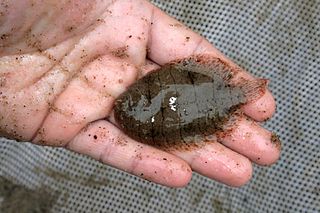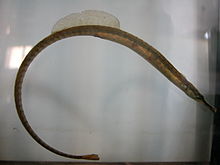
Pipefishes or pipe-fishes (Syngnathinae) are a subfamily of small fishes, which, together with the seahorses and seadragons, form the family Syngnathidae.

Syngnathus is a genus of fish in the family Syngnathidae found in marine, brackish and sometimes fresh waters of the Atlantic, Indian and Pacific Ocean. Fossils of these species are found from the Oligocene to the Pleistocene. They are known from various localities of Greece, Italy, Germany and United States.

The hogchoker is a small species of flatfish found along the Atlantic and Gulf coasts of North and South America, ranging from Massachusetts to Venezuela. They prefer brackish water, and are abundant in many bays and estuaries north of the Carolinas. It is a member of the American sole family Achiridae. They are usually brown to dark brown in color, and lighter on their "blind side". The overall body color is often broken by a series of spots and thin stripes, which can be lighter or darker than the main body color. The fins and tail have fringed edges helping hide the fish from its prey. They mainly feed on small aquatic insects and invertebrates. They are regarded as "trash fish" by recreational fishermen and were fed to pigs but they have rather bony bodies which were sometimes difficult for the pigs to swallow, hence the vernacular name.

The greater pipefish is a pipefish of the family Syngnathidae. It is a seawater fish and the type species of the genus Syngnathus.

The lesser pipefish or Nilsson's pipefish is a pipefish similar to the greater pipefish, but with no crest above the head. Usually it reaches up to 17 centimetres (6.7 in) in length, maximally 18 centimetres (7.1 in), although in South Wales they are usually not more than 10 to 13 centimetres long. They have a light to dark green-brown colour with bar-like markings on the sides.

The black-striped pipefish is a species of fish in the family Syngnathidae. It is found in the eastern Atlantic from the southern Gulf of Biscay to Gibraltar, also in the Mediterranean and Black Seas. As the introduced species it is mentioned in the Caspian Sea and fresh waters of its basin.
Microphis lineatus, the opossum pipefish, is a species of fish in the family Syngnathidae. It is found in fresh, brackish and marine waters in the West Atlantic region, ranging from New Jersey, United States, to São Paulo, Brazil, including the Caribbean and Gulf of Mexico. It is often found in rivers, among water hyacinth roots, in mangrove and in Sargassum.

The broadnosed pipefish or deepnosed pipefish is a fish of the family Syngnathidae. It is native to the Eastern Atlantic from Vardø in Norway, Baltic Sea and the British Isles at north to Morocco at south. It is also found in the Mediterranean Sea, Black Sea and Sea of Azov. It is common in the coastal shallow waters, usually on reefs with seagrasses. This species is notable for its "broad" snout, which is as deep as its body.
Syngnathus schmidti, the Black Sea pelagic pipefish or Schmidt's pipefish, is a pipefish species that inhabits the Black Sea and Sea of Azov. A freshwater/brackishwater fish, it can grow up to 11 centimetres (4.3 in) long and usually lives at a depth of 1 to 10 metres, although it can live as deep as 100 metres (330 ft). The specific name honours the Danish zoologist Ernst Johannes Schmidt (1877-1933).
Pelagic pipefish is a pipefish species of the family Syngnathidae.

The sargassum pipefish is a species of pipefish found in the western Atlantic: Maine, Bermuda, northern Gulf of Mexico to Argentina, Nova Scotia, Antilles, and western Caribbean Sea from Yucatan to Colombia. It is a marine subtropical species, up to 18.1 centimetres (7.1 in) maximal length. This is a little-studied species which is found in floating rafts of Sargassum weed where they are believed to feed on planktonic crustacea. Like other pipefish, this is an ovoviviparous species in which the male carries the fertilised eggs in a brood pouch located under his tail.
Syngnathus carinatus is a species of the pipefish, which is endemic of the northern part of the Gulf of California. It is a marine / freshwater subtropical demersal fish, which grows up to 23 centimetres (9.1 in) length.
The chain pipefish is a pipefish species. It inhabits the western Atlantic from Virginia, Bermuda and northern Gulf of Mexico to Campeche and Jamaica, but is absent from the Bahamas. It is a marine subtropical reef-associated fish, up to 38 cm length.

The Gulf pipefish is a species of pipefish in the member of the taxonomic family Sygnathidae. Syngnathus scovelli is native to the region of south Florida, United States, the Atlantic Ocean, etc. S. scovelli is similar to the species Opossum pipefish also known by its scientific name as Microphisbrachyurus.
The Yucatán pipefish is a demersal fish species native to the Gulf of Mexico.

The snake pipefish is a species of pipefish, from the family Syngnathidae, native to the northeastern Atlantic Ocean where they are generally found amongst algae close in to shore. It is the largest species of pipefish recorded in European waters and has spread into arctic waters in the early 2000s.
Choeroichthys latispinosus, also known as the Muiron Island pipefish or Muiron pipefish, is a species of pipefish native to the western coast of Western Australia, named for its recorded sighting on South Murion Island. It is thought to inhabit the area from Port Denison to Brecknock Island in the eastern Kimberley region.
Gyrodactylus leptorhynchi is a small monogenean obligate ectoparasite which parasitizes freshwater bay pipefish. Gyrodactylus leptorhynchi is the seventh Gyrodactylus species known to infect bay pipefish and the first characterized along the Pacific coast of North America. The parasite can get into captive fish environments, such as fish farms and aquariums, where it may spread in as little as 10 days. Gyrodactylus species are known to centralize on the brood pouch in male fish, this may allow for transmission to newly hatched young. However, in Gyrodactylus leptorhynchi the parasite was found mostly found attached to body surfaces such as the dorsal fins.
Phoxocampus diacanthus, also known as the obscure pipefish or spined pipefish, is a species of marine fish belonging to the family Sygnathidae. It can be found inhabiting reefs throughout the Indo-Pacific from Japan and Sri Lanka to Samoa and New Caledonia in the south. Its diet likely consists of small crustaceans. Reproduction occurs through ovoviviparity in which the males brood eggs before giving live birth.
Trachyrhamphus longirostris, also known as the long-head pipefish or straightstick pipefish, is a species of marine fish belonging to the family Syngnathidae. They can be found in muddy estuaries on the continental shelf throughout the Indo-Pacific from Eastern Africa to the Solomon Islands and Japan. The diet of Trachyrhamphus longirostris likely consists of small crustaceans. Adult individuals can grow to be approximately 33 centimeters in length. Reproduction occurs through ovoviviparity in which males brood eggs before giving live birth.










